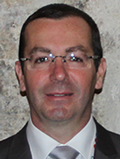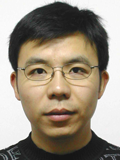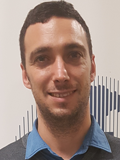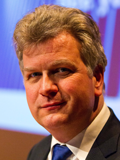ISQED'18 Embedded Tutorials
Chair & Moderators:
Vinod Viswanath - Real Intent
Tuna Tarim- Texas Instrument, Inc. (Co-Chair)
Tutorial 1
Tuesday, March 13, 1:35:00PM-2:35PM
Power-Aware Testing in the Era of IoT
Presenter:
Patrick Girard, LIRMM / CNRS - University of Montpellier / France
 Patrick Girard
Patrick Girard Abstract: Managing power consumption of circuits and systems is one of the most important challenges for the semiconductor industry in the era of IoT. Power management techniques are used today to control the power dissipation during functional operation. Since the application of these techniques has profound implications on manufacturing test, power-aware testing has become indispensable for low-power LSIs and IoT devices. This tutorial provides a comprehensive and practical coverage of power-aware testing. Its first part gives the background and discusses power issues during test. The second part provides comprehensive information on structural and algorithmic solutions for alleviating test-power-related problems. The third part outlines low- power design techniques and shows how low-power devices can be tested safely without affecting yield and reliability.
About Patrick Girard
Patrick GIRARD received a M.Sc. degree in Electrical Engineering and a Ph.D. degree in Microelectronics from the University of Montpellier, France, in 1988 and 1992 respectively. He is currently Research Director at CNRS (French National Center for Scientific Research) and works in the Microelectronics Department of the Laboratory of Informatics, Robotics and Microelectronics of Montpellier (LIRMM) - France. From 2010 to 2014, he was head of this Microelectronics Department. He is co-Director of the International Associated Laboratory « LAFISI » (French-Italian Research Laboratory on Hardware-Software Integrated Systems) created in 2013 by the CNRS and the University of Montpellier with the Politecnico di Torino, Italy. His research interests include all aspects of digital testing and memory testing, with emphasis on critical constraints such as timing and power. Reliability and fault tolerance are also part of his research activities. He has served on numerous conference committees and is the founder and Editor-in-Chief of the ASP Journal of Low Power Electronics (JOLPE). He is also an Associate Editor of the IEEE Transactions on Computers, IEEE Transactions on CAD and the Journal of Electronic Testing – Theory and Applications (JETTA - Springer). He has supervised 37 PhD dissertations and has published 7 books or book chapters, 65 journal papers, and more than 230 conference and symposium papers on these fields. Patrick Girard is a Fellow of IEEE.
Tutorial 2
Tuesday, March 13, 2:35PM-3:35PM
Ambient Energy Harvesting Sensor Platform for Internet of Things: From Circuit to System
Presenter:
Prof. Yongpan Liu, Tsinghua University, P.R. China
Prof. Jingtong Hu , University of Pittsburgh
 Yongpan Liu
Yongpan LiuAbstract: Internet of things are regarded as a very promising market in the next decade. However, batteries have become as a critical obstacle due to their limited operating time and frequent maintenance. Energy harvesting techniques are proposed to relieve those problems and self-powered sensor nodes are attracting more and more attentions. A typical self-powered sensor node consists of power supply and computation system, and it collects energy from ambient power sources, such as solar, vibration, temperature difference and RF energy. Several major design challenges exist in the present self-powered sensor nodes: 1) Limited output power: The typical generated power ranges from several mW to hundreds of uW, leading to a gap of several orders of magnitude between the harvested energy and the consumption of mainstream low power chips. 2) Frequent power failures: Lots of power failures occur frequently in self-powered systems, requiring efficient operations in an energy intermittent mode. 3) Hard to predict: The power profiles are determined by the ambient factors and hard to be predicted. This tutorial will provide several state-of-the-art techniques from circuit levels to system levels to handle above challenges, including nonvolatile processor design, architecture exploration, software and system optimization techniques for energy harvesting sensor platform. Finally, we demonstrate a smart ultraviolet monitoring system using CNN-based pattern recognition on the platform.
About Yongpan Liu
Dr. Yongpan Liu received his B.S., M.S. and Ph.D. degrees from Electronic Engineering Department, Tsinghua University in 1999, 2002 and 2007. He was a visiting scholar at Pennsylvania State University in 2014. He is a key member of Tsinghua-Rohm Research Center and Research Center of Future ICs. He is now an associate professor in Dept. of Electronic Engineering Tsinghua University. His main research interests include nonvolatile computation, low power VLSI design, emerging circuits and systems and design automation. He has published over 100 peer-reviewed conference and journal papers and led over 6 chip design projects for sensing applications, including the first nonvolatile processor (THU1010N). His research is supported by NSFC, 863, 973 Program and Industry Companies such as Huawei, Rohm, Intel and so on. These projects lead to the first nonvolatile processor THU1010N and a series of advanced versions. The line of processors has been adopted for the research of self-powered sensing platforms in 7 universities His work has received Under 40 Young Innovators Award DAC 2017, Micro Top Pick 2016, Best Paper Award in ASPDAC2017, HPCA 2015, 2 Design Contest Awards in ISLPED 2012 and 2013, and 2 Best Paper Nominations in ASPDAC 2013 and 2016. He holds 7 authorized Chinese patents and 1 authorized U.S. patent.
Tutorial 3
Wednesday, March 14, 1:30PM-2:30PM
Ultra-Low-Power Digital Architectures for the Internet of Things
Presenter:
Prof. Davide Rossi, DEI, University of Bologna
 Davide Rossi
Davide RossiAbstract: A growing number of Internet of Things (IoT) applications require flexible processing of data streams generated by multiple sensors, such as accelerometers, low-resolution cameras, microphone arrays, and vital signs monitors. These applications share the need for high performance and extreme energy efficiency in a power envelope of a few milliWatts, while keeping the flexibility of software programmable architectures to deal to the vast variety of near-sensor data analytics algorithms. This tutorial presents an overview of the emerging architectures implementing the digital processing and control platforms for Internet of things applications. It will provide a review of the state of the art Ultra-Low-Power (ULP) micro-controllers architectures, highlighting main challenges and perspectives, and introducing the potential of exploiting parallel near-threshold computing in this field currently dominated by single-issue processors..
About Davide Rossi
David Rossi received the PhD from the University of Bologna, Italy, in 2012. He has been a post doc researcher in the Department of Electrical, Electronic and Information Engineering “Guglielmo Marconi” at the University of Bologna since 2015, where he currently holds an assistant professor position. His research interests focus on energy efficient digital architectures in the domain of heterogeneous and reconfigurable multi and many-core systems on a chip. This includes architectures, design implementation strategies, and runtime support to address performance, energy efficiency, and reliability issues of both high end embedded platforms and ultra-low-power computing platforms targeting the IoT domain. In this fields he has published more than 60 paper in international peer-reviewed conferences and journals.
Tutorial 4
Wednesday, March 14, 2:30PM-3:30PM
Managing the ever increasing complexity of Cyber-Physical Systems in High-Tech Industry
Presenter:
Dr. Wouter Leibbrandt, Embedded Systems Innovation, TNO, The Netherlands
 Wouter Leibbrandt
Wouter Leibbrandt Abstract: The complexity of advanced cyber-physical systems is ever increasing, making it progressively more difficult to design in a proper and efficient way for system properties such as e.g. performance, reliability, upgradability, safety and security. High tech cyber-physical systems as diverse as industrial printers, cars, medical imaging and IC-manufacturing equipment often contain hundreds of processing elements, tens of millions of lines-of-code, with thousands of interfaces. The same holds for distributed systems like IoT. Architects and designers are rapidly losing grip and overview. A more fundamental basis of embedded systems engineering is being developed to address these issues and starting to be applied. This Model-Based Systems Engineering (MBSE) approach aims at reasoning about non-functional, system, properties such as performance from the highest system architecture level down to the engineering level for individual components. Objective is to assure that in the end system requirements and stakeholder needs are fulfilled, and that components and systems can be tested and validated in a meaningful way. In this tutorial we introduce some of the key principles, such as executable models and domain specific languages, and concerns of MBSE, and present examples from the car entertainment and industrial printing domains. Furthermore, we discuss the current developments which will further increase complexity of cyber-physical systems in the near future, such as autonomous systems and adaptive and learning systems.
About Wouter Leibbrandt
Wouter Leibbrandt is general manager of the Embedded Systems Innovation department in TNO (TNO-ESI). TNO-ESI focusses on the development of new methods and techniques for design and engineering of increasingly complex high-tech (embedded) systems. It does so in strong partnership and close collaboration with leading high-tech companies such as ASML, Philips, Thales, NXP, Océ, Thermo-Fisher and DAF as well as with leading academic groups in the Netherlands and across Europe. Until early 2016 Wouter was with NXP Semiconductors for 10 years, where he managed the Advanced Applications Lab, investigating new application concepts around future advanced silicon products, driving secure connections for a smarter world. The recurring theme here is that everything is getting connected with everything (IoT). Before joining NXP, he was with Philips Research labs for 14 years, managing a variety of projects and departments. From 2004 to 2006 he lived and worked in China, founding and managing part of the Philips Research labs in Shanghai. Wouter holds a PhD in physics from Utrecht University.

